Nothing is more captivating than the glow of ancient gold under museum lights, except maybe for ancient gold in an auction showroom – that is, ancient jewels you could, conceivably, own. Or at least hold, however briefly.

Gold jewelry from the ancient Mediterranean has a particular thrill that carries through the millenia, capturing the sensuality and extraordinary intelligence of the cultures that thrived there.
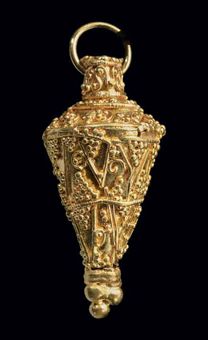
Poets were waxing nostalgic for the heyday of gold jewelry even before the birth of Christ. As Horace (Quintus Horatius Flaccus, 65-8 B.C.) put it: “The centuries roll back to the ancient age of gold…”
Some experts believe goldsmithing had reached its peak even before the Hellenistic period, when the earrings on this page were made.
“The quality of Etruscan filigree and granulation never really has been surpassed in any other period,” Max Bernheimer, director of antiquities at Christie’s New York, told me once in a magazine interview, referring to the culture that developed in Italy around 800 B.C.
He explained that Etruscan art and gold work were influenced by the Greeks as well as the ancient Near and Far East before giving way, like the Etruscans themselves, to Roman and Hellenistic style. “So Etruscan art is is very eclectic and unique.”
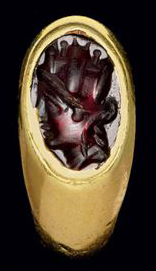
Many of today’s most skilled and innovative designers refer to the work of goldsmiths throughout ancient civilization with awe and admiration, seeking inspiration from both form and technique.
Because ancient gold jewelry was worn at galas and civic functions by the wealthiest of society, it reflects high fashion as well as fine art. The upper echelons of Greece, Rome and Etruria took their ornament seriously.
The result is that while you find motifs from ancient sculpture echoed in earrings and paintings in diadems, you also find concessions to popular trends. Ancient gold jewelry is high and low culture twisted, hammered, and soldered together into some of the finest goldwork ever produced.
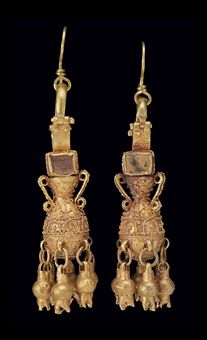
Despite all that modern technology has contributed to the jeweler’s studio, it’s amazing how little the basics of goldsmithing have changed. There are ornaments made 2,000 years ago with hand tools and the naked eye that leave contemporary goldsmiths scratching their heads.
Just how the Etruscans achieved such fine granulation, for example, is still debated. Did they directly fuse those tiny gold beads or use an adhesive?
Regardless, few have been able to match the precision of the intricate patterns and textures found on the surfaces of Etruscan fibulae – the ancient ancestor of the safety pin that held fabric together, often at a woman’s shoulder – or the lacy filigree on a Greek diadem. You almost need a magnifying glass to appreciate the workmanship.
Raw gold was rare in the Mediterranean before Alexander the Great conquered Egypt and the Near East in the 4th century B.C. Before that, goldsmiths had to make creative use of a very limited resource. Sheet gold was hammered as thin as possible and goldsmiths concentrated on surface treatments.
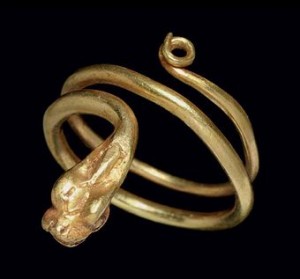
Along with applied decoration like granulation and filigree, sheet metal was engraved and molded. Chasing and repousée, for example, methods of hammering a design from front and behind, were relied on instead of casting, which involved pouring molten metal into molds.
“The virtue of repoussé is that it makes gold go just about as far as it can go,” Anne Bromberg, curator of ancient art the Dallas Museum Art, once explained to me. “You get a maximum amount of glitz and impact from a minimum amount of precious metal.”
You can find beautiful examples of ancient Greek, Etruscan and Roman goldwork at the Dallas Museum of Art, as well as at the Metropolitan Museum of Art and Boston Museum of Fine Arts, including some of the finest examples of repoussé, granulation and filigree ever achieved.
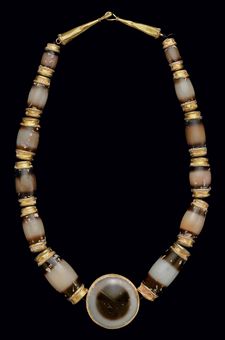
Not all ancient gold ends up in museums, of course. Everything you see on this page was sold at Christie’s New York in December, along with ancient gold rings for less than $2,000 and museum-quality pieces like an exquisite cameo of Minerva that went for $60,000.
Personally, I prefer to see pieces like that end up in museums where we can all ogle them, but it’s nice to know that even us humble non-billionaires can aspire to own a gold ring that once graced the hand of someone in Ancient Rome.
Expect to find some ancient gold at the June antiquities sales of the New York branches of Sotheby’s and Christie’s. Look for details of these and other upcoming sales on our constantly-updated auction calendar.
Related posts:
How to buy ancient jewelry for $3000 or less
What you need to know about collecting ancient jewels
Related products:
Note: Buying through links on this site puts a couple bucks toward blog maintenance.

